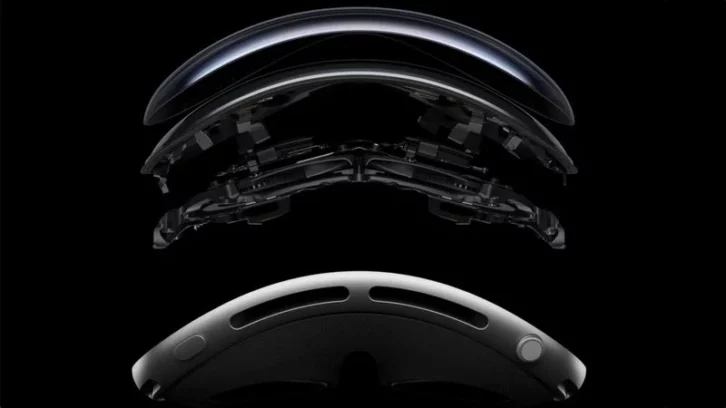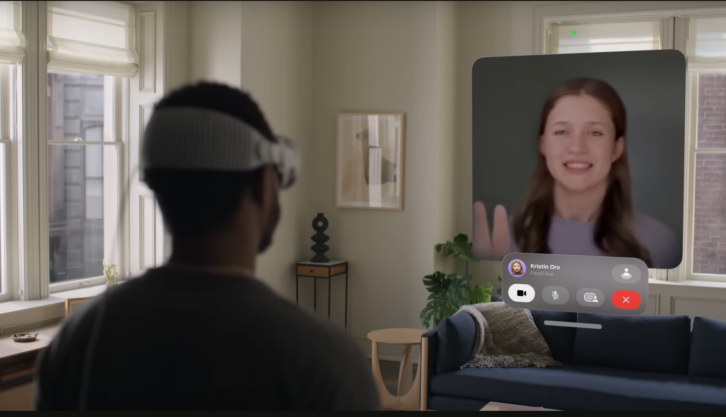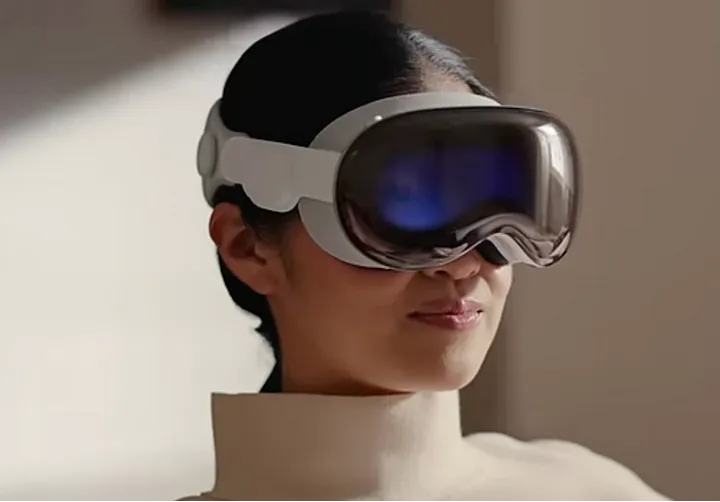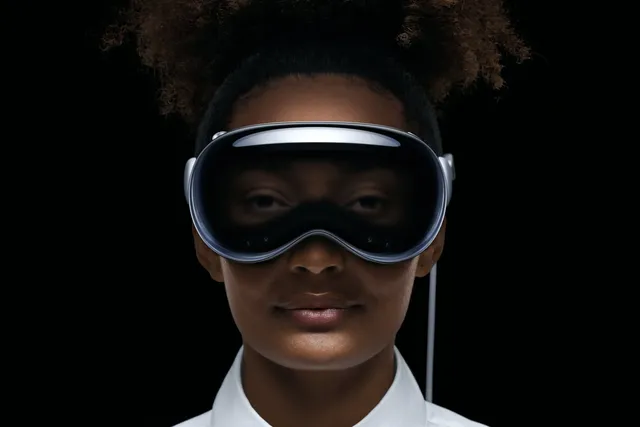
Earlier this year, Apple’s newest iPad Pro models featuring a tandem-OLED screen were released to much fanfare. Shortly after, LG Display announced that it had begun the mass-production of said tandem-OLED display for use in its own laptops, as well as other brands. Now, reports are emerging that the tandem display technology has made its way to the micro-OLED world, where it is being positioned as possibly having a future in the next generation of Apple Vision Pro headsets.
The tandem setup in OLED displays involves stacking two OLED panels, resulting in increased brightness, performance, and lifespan. South Korean publication Sisa Journal has reported that LG Display and Samsung have both launched prototypes that utilize the tandem-OLED design in micro-OLED displays, and that the Apple Vision Pro is a likely vehicle for the display type. The current Apple Vision Pro includes micro-OLED displays manufactured by Sony, which were given extremely high marks by reviewers upon the device’s release. This new innovation could increase the Vision Pro display’s brightness and energy efficiency.
The following was originally published June 20, 2024:
The story of the Apple Vision Pro continues to unfold, as a report has emerged that Apple is pivoting away from the next iteration of the AR device to focus on a cheaper version. The company was originally going to simultaneously develop a more affordable, stripped-down Vision Pro alongside the next version of the base high-end model, but according to The Information, Apple has cancelled the next base model to focus completely on the more feature-light, affordable version.
Previous reports noted that Apple has had production difficulties regarding the Apple Vision Pro’s initial launch, not to mention the hurdle of selling consumers on a $3,500 device. The report notes that even though the original Apple Vision Pro has just launched in several new markets, it will not produce “significantly more” units than the 500,000 already created. The Information, who cites two Apple employees, states that the cheaper model should land somewhere around the $1,600 price range and launch by the end of next year. As is to be expected, this version will likely reduce the number of inward and outward-facing cameras, cut cost on speakers, and be overall less bulky than the base model.
The following was originally published April 25, 2024:
Apple is engaging in some course correction, according to analyst reports that say that the company has cut production of the Apple Vision Pro due to a drop in demand.
While initial reviews were mostly glowing, the internet noticed a trend of early adopters of the AR headset returning their devices, with the most common causes being discomfort from the headset and eye strain. Now, analyst Ming-Chi Kuo, who reports heavily on Apple, says that not only is the company cutting production numbers, but did so before the Vision Pro even entered non-U.S. markets, pointing to a sharp decline in demand within the U.S.
WATCH: Apple Vision Pro teardown part 2
Initial reports pointed to the upcoming production of a cheaper Vision Pro model, which could theoretically boost sales, as the $3,500 price tag of the original is a difficult pill to swallow for most. This may still be the case, but Kuo points out that Apple is adjusting its roadmap for head-mounted display technology, and if the company predicts that demand doesn’t require further display production, the chances of a cheaper model may be slim to none.
The following was originally published March 11, 2024:

Apple continues to roll out fixes for the recently released Apple Vision Pro, with the new visionOS 1.1 update being the most substantial yet. Users of the AR headset for work meetings may be the most interested in this one, as it includes improvements for the Persona feature, as well as some ironing out of virtual keyboard.
IMAX streams documentaries in 3D, 1.43:1 aspect ratio on Apple Vision Pro
For Personas, the digital avatar that virtual meeting attendees see of the Vision Pro user’s face, a number of requested tweaks have been made. Response to the feature on the device’s release were mixed, with many commenting that the Personas had an “uncanny valley” effect. To address this, Apple’s release notes say that they have improved “hair and makeup appearance” and “neck and mouth representation” for the Persona feature, which Apple notes as being in Beta. Additionally, Apple’s notes say they have improved “rendering of the eyes” for EyeSight, the feature that projects a view of the user’s eyes on the externally-facing OLED display to allow the user to make a sort of virtual eye-contact with those around them.
Reception to the Apple Vision Pro’s virtual keyboard was underwhelming on launch, and the company is seemingly addressing this with a number of improvements. Those tweaks include:
● Cursor positioning for text input is now more accurate
● Resolves some instances where the virtual keyboard placement obscures the text input field
● Fixes an issue where in some cases, the text preview on the virtual keyboard may appear out of sync with the text field in the app
● Fixes an issue where the edit menu may appear unexpectedly
Whether these changes will see more people utilizing the virtual keyboard instead of alternative input methods remains to be seen, but hopefully we will all be air-typing in the not-too-distant future.
The following was originally published February 14, 2024:
Apple Vision Pro owners rejoice, as a new software update has rolled out to smooth out some of the device’s issues. Upon launch, users who had forgotten their passcode were required to either visit an Apple Store or ship their device to customer support in order to reset their AR headset.
WATCH: Apple Vision Pro teardown
Thankfully, the Vision Pro’s first update (visionOS 1.0.3) has arrived to remedy the issue. While thieves would still be unable to access the device without the proper Apple ID, the update has made it so users can now manually reset their device at home. “This update provides important bug fixes and adds an option to reset your device if you’ve forgotten your passcode,” reads Apple’s announcement. Apple has not disclosed what bug fixes are included in the update.
The following was originally published January 25, 2024:
UPDATE: It seems that the preorders for the Apple Vision Pro sold out almost immediately after opening on January 19th. While initial estimates had Apple producing anywhere from 60,000 to 80,000 devices, some analysts, including Ming-Chi Kuo, now believe that the company sold up to 180,000 units during the preorder window.
While this new estimate eclipses earlier predictions, it isn’t all great news for Apple. Kuo believes that, as the estimated shipping time for each preorder has remained at five to seven weeks, its possible that demand may have dropped after the diehard Apple fans placed their order. While this was only the first batch of Vision Pros, rumors suggest that Apple is already working on new models of the device, including a more affordable option.
The following was originally published January 10, 2024:

Apple has surprised the industry by announcing that the Apple Vision Pro will officially launch February 2nd, beating the rumored release date by an entire month.
The company’s announcement states that the Vision Pro will be available both in all U.S. Apple stores and through the U.S. Apple store online, with preorders opening up Friday, January 19. The initial model of the highly-anticipated headset will run for $3,499 with and come with a storage capacity of 256Gb.
Apple states the Vision Pro will come with two different types of headbands to choose from, along with a Light Seal, two Light Seal Cushions, an Apple Vision Pro Cover for the front of the device, Polishing Cloth, Battery, USB-C Charge Cable, and USB-C Power Adapter. Additionally, those who wear corrective glasses can purchase ZEISS Readers for $99 and ZEISS Prescription Optical Insert for $149.
The following was originally published October 17, 2023:
Bloomberg’s Mark Gurman has shed some more insight into Apple’s plans for upcoming Vision Pro models, this time through the Power On newsletter.
It’s been revealed previously that Apple is working on a more affordable Vision Pro model that would leave off some of the base model’s features. Gurman reports that the cheaper version would retail for somewhere between $1,500 and $2,500. To reach this price point, Gurman says the model would “likely” forgo an external display, which would notably disable some of the Vision Pro’s most talked about features. These include EyeSight, which is the headset’s ability to render an image of the wearer’s eyes on the outside of the display, so onlookers can make eye contact, or otherwise be informed as to where the wearer is looking.
Other downgrades that will most likely be present in the cheaper headset would be a reduction in the number of cameras (the base model includes 12), lower resolution displays, and a less premium CPU, most likely an iPhone chip. Users will have to decide if these downgrades still merit a price point of around $2,000, but hands-on reviews for the $3,500 base model have so far been promising.
The following was originally published October 12, 2023:
According to a report by Bloomberg’s Mark Gurman, Apple is already planning on updates for a second generation Apple Vision Pro. While the first generation device hardware has reportedly been finished for months, Apple is looking for a way to reduce neck strain that some testers experienced while wearing the device. An optional, secondary strap that goes across the top of the device is being tested as a solution, but it seems that Apple is intent on making further modifications for a second generation release., including reducing the overall size and weight of the wearable.
WATCH: iPhone 15 Pro Max Teardown
Gurman also states that the company isn’t fully satisfied with the way the Vision Pro is currently integrating prescription lenses. While the first generation release will feature interchangeable Zeiss lenses, Gurman says they have been “a headache for Apple’s operations teams.” Alternative solutions that are being considered include having future devices manufactured with prescription lenses built-in, though that idea brings with it its own set of logistical issues.
The following was originally published September 14, 2023:
WATCH: Record spatial video with the iPhone 15 Pro, step into your footage with the Vision Pro
In Tuesday’s unveiling of the upcoming iPhone 15 Pro, Apple revealed a feature that will theoretically allow you to relive moments using the Apple Vision Pro. Pushing the concept of “spatial video” and “spatial photos,” the company explained that the upcoming phone’s new camera system, when coupled with the new A17 Pro CPU, will allow users to capture “3D video” and photos, that they can later move around in using the upcoming mixed reality device.
Apple explains that capturing these videos is accomplished by the phone recording using both the main camera and wide-angle camera simultaneously, then combining footage from both within the phone’s operating system. These photos and videos are sharable, allowing your friends to step into your memories, provided that they have an Apple Vision Pro.
The following was originally published September 5, 2023:
We previously reported that Apple has had to make significant cuts to the production of the Vision Pro, chiefly due to the sheer number of defective micro-OLED displays being produced by their contracted assembler, Luxshare. Now it seems the company may be having to change course once again, this time due to supply chain issues.
As reported by The Information, Apple is considering switching from their current micro-OLED supplier, Sony, to Chinese manufacturers due to supply shortages. Sony is reportedly hesitant to increase production, while Apple is trying to look at every option to remedy their issues with slowing production. Apple is already reportedly testing displays from BOE Technology and SeeYa Technology for potential use in both a next-gen Apple Vision Pro as well as a future, lower-cost mixed reality headset. Both of these companies have committed to micro-OLED display technology, backed by local government initiatives.
The following was originally published August 2, 2023:

Developers working on applications for the Apple Vision Pro have access to a range of tools, including actual hardware prior to the device’s official release. While it’s no surprise that security over such devices might be stringent, the actual lengths Apple has gone to to keep the device shrouded in secrecy has been revealed.
As reported by Ars Technica, the Terms and Conditions document for the Vision Pro Developer Kit is particularly restrictive. Specifically, under the “care and storage” section, developers are advised that the device must remain within line of sight at all times. The full paragraph reads:
“You agree that all access to, usage of, and storage use of the DK will be in a private, secure workspace accessible only by You and Your Authorized Developers (e.g., fully enclosed with solid doors, floors, walls and ceiling, and locks that can be engaged when the DK is in use). You must ensure that unauthorized persons (including any family, friends, roommates or household employees) do not access, view, handle, or use the DK. When in use, the DK should be in your positive control (on your person or within Your direct line of sight) at all times. You must ensure the DK is passcode protected. Never leave the DK unattended. When not in use, turn off the DK and store it in its locked Pelican case in a locked space that only You have access to (e.g., a locked room or closet, a safe or locked drawer). The DK may not be moved from or taken away from its ship-to address by You or Your Authorized Developers without Apple’s prior written consent. If You will be away from Your workspace for more than 10 days, consult with Your Apple point of contact about how to keep the DK safe while You are away. You agree to restrict access to the DK to You and Your Authorized Developers, and to take all reasonable precautions to safeguard the DK from loss or theft.”
Additionally, the Developer Kit must be returned to Apple within 90 days of the Vision Pro’s official launch, or at any time by Apple’s request.
The following was originally published July 5, 2023:
According to a new report by the Financial Times, Apple has had to make significant cuts to the production of the Vision Pro.
The report states that though Apple’s internal target for production for 2024 was 1 million units, Luxshare, Apple’s contracted assembler for the device, is prepared to make fewer than 400,000 in that time frame.
Complications that have lead to this scenario include Apple being unhappy with the amount of micro-OLED displays being produced without defects, the report states. Furthermore, it seems that Apple has been planning to launch a less costly version of the device (the base model will retail for $3,500), but these plans will be pushed back further due to complications stemming from micro-OLED display production.
Some industry experts are not surprised, with Bloomberg Intelligence analysts Anurag Rana and Andrew Girard saying, “[It] isn’t surprising to us, as it’s a first-generation product…Our original thesis called for only 500,000 units in the first year given the headset’s $3,500 price tag. We don’t expect the product to have significant financial impact for the next three years.”
The following was originally published June 5, 2023:
After much anticipation, Apple has officially revealed their augmented reality headset. The Apple Vision Pro is unique in its lack of physical controllers. Instead, menus are controlled by looking at them via eye tracking, as well as voice commands and hand tracking. Further differentiating it from other AR/VR headsets on the market is its ability to toggle between augmented reality and full virtual reality via a dial.
See also: Sonos awarded $32 million in patent infringement case with Google
Its glass, ski-goggle like visor is housed in an aluminum frame containing 12 cameras along with 5 displays, and according to Apple, displays video in 4K. An external battery supplies up to two hours of battery life, and Bluetooth connectivity allows the user to use their Mac with the Vision Pro.
Apple calls the device’s display system “EyeSight,” which allows full transparency and your eyes to be visible during AR, but if toggled to full VR, your eyes will be obscured to let people know you are unavailable. The Vision Pro will support video calling through FaceTime, and most interestingly, will allow you to “relive” 3D video that the device has captured. Apple says that the headset will launch with full support for Disney+ and arcade.
Slated for an early 2024 release, the Apple Vision Pro will retail for $3,499
This story will be updated once more information becomes available.










